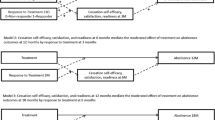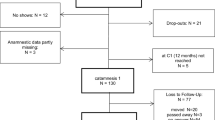Abstract
Background
Most people who quit smoking relapse within a year of quitting. Little is known about what prompts renewed quitting after relapse or how often this results in abstinence.
Purpose
This study seeks to identify rates, efficacy, and predictors of renewed quit attempts after relapse during a 1-year follow-up.
Methods
Primary care patients in a comparative effectiveness trial of smoking cessation pharmacotherapies reported daily smoking every 6–12 weeks for 12 months to determine relapse, renewed quitting, and 12-month abstinence rates.
Results
Of 894 known relapsers, 291 (33 %) renewed quitting for at least 24 h, and 99 (34 %) of these were abstinent at follow-up. The average latency to renewed quitting was 106 days and longer latencies predicted greater success. Renewed quitting was more likely for older, male, less dependent smokers, and later abstinence was predicted by fewer depressive symptoms and longer past abstinence.
Conclusions
Renewed quitting is common and produces meaningful levels of cessation.

Similar content being viewed by others
References
World Health Organization. Tobacco Free Initiative. www.who.int/tobacco/mpower/tobacco_facts/en/index.html. 2010.
World Health Organization Global Report. Mortality attributable to tobacco. http://whqlibdoc.who.int/publications/2012/9789241564434_eng.pdf. 2012.
Centers for Disease Control and Prevention. Quitting smoking among adults—United States, 2001–2010. MMWR Morb Mortal Wkly Rep. 2011; 60: 1513-1519. Retrieved from http://www.cdc.gov/.
Borland R, Partos TR, Yong H-H, Cummings KM, Hyland A. How much unsuccessful quitting activity is going on among adults smokers? Data from the International Tobacco Control Four Country cohort survey. Addiction. 2012; 107: 673-682.
Fiore MC, Jaén CR, Baker TB, et al. Treating tobacco use and dependence: 2008 update U.S. public health service clinical practice guideline. Respir Care. 2008; 53: 1217-1222.
Centers for Disease Control and Prevention. Cigarette smoking among adults—United States, 2000. MMWR Morb Mortal Wkly Rep. 2002; 51: 642-645. Retrieved from http://www.cdc.gov/.
Lando HA, McGovern PG, Barrios FX, Etringer BD. Comparative evaluation of American Cancer Society and American Lung Association smoking cessation clinics. Am J Public Health. 1990; 80: 554-559.
Borland R, Yong HH, Balmford J, et al. Motivational factors predict quit attempts but not maintenance of smoking cessation: Findings from the International Tobacco Control Four country project. Nicotine Tob Res. 2010; 12: s4-s11.
Partos TR, Borland R, Yong HH, Hyland A, Cummings KM. The quitting rollercoaster: How recent quitting history affects future cessation outcomes (data from the International Tobacco Control 4-Country Cohort Study). Nicotine Tob Res. 2013; 15: 1578-1587.
Fu SS, Partin MR, Snyder A, et al. Promoting repeat tobacco dependence treatment: Are relapsed smokers interested? Am J Manag Care. 2006; 12: 235-243.
Joseph A, Rice K, An L, Mohiuddin A, Lando H. Recent quitters’ interest in recycling and harm reduction. Nicotine Tob Res. 2004; 6: 1075-1077.
Carlini BH, McDaniel AM, Weaver MT, et al. Reaching out, inviting back: Using interactive voice response (IVR) technology to recycle relapsed smokers back to Quitline treatment-A randomized controlled trial. BMC Public Health. 2012; 12: 507-515.
Zhou X, Nonnemaker J, Sherril B, Gilsenan AW, Coste F, West R. Attempts to quit smoking and relapse: Factors associated with success or failure from the ATTEMPT cohort study. Addict Behav. 2009; 34: 365-373.
Hughes JR, Solomon LJ, Fingar JR, Naud S, Helzer JE, Callas PW. The natural history of efforts to stop smoking: A prospective cohort study. Drug Alcohol Depend. 2013; 128: 171-174.
Hughes JR, Callas PW. Definition of a quit attempt: A replication test. Nicotine Tob Res. 2010; 12: 1176-1179.
Hughes JR, Gulliver SB, Fenwick JW, et al. Smoking cessation among self-quitters. Health Psychol. 1992; 11: 331-334.
Shiffman S, Brockwell SE, Pillitteri JL, Gitchell JG. Use of smoking-cessation treatments in the United States. Am J Prev Med. 2008; 34: 102-111.
Hedeker D, Mermelstein RJ. Application of random-effects regression models in relapse research. Addiction. 1996; 91: S211-S229.
Partin MR, An LC, Nelson DB, et al. Randomized trial of an intervention to facilitaterecycling for relapsed smokers. Amer J Prev Med. 2006; 31: 293-299.
Smith SS, McCarthy DE, Japuntich SJ, et al. Comparative effectiveness of 5 smoking cessation pharmacotherapies in primary care clinics. Arch Intern Med. 2009; 169: 2148-2155.
van den Putte B, Yzer M, Willemsen MC, de Bruijn GJ. The effects of smoking self-identify and quitting self-identify on attempts to quit smoking. Health Psychol. 2009; 28: 535-544.
DiClemente CC, Prochaska JO, Fairhurst SK, Velicer WF, Velasquez MM, Rossi JS. The process of smoking cessation: An analysis of precontemplation, contemplation, and preparation stages of change. J Consult Clin Psychol. 1991; 59(2): 295-304.
West R, McEwen A, Bolling K, Owen L. Smoking cessation and smoking patterns in the general population: A 1-year follow-up. Addiction. 2001; 96: 891-902.
Dijkstra A, De Vries H, Bakker M. Pros and cons of quitting, self-efficacy, and the stages of change in smoking cessation. J Consult Clin Psychol. 1996; 64(4): 758-763.
Hyland A, Borland R, Li Q, et al. Individual-level predictors of cessation behaviors among participants in the International Tobacco Control (ITC) Four Country Survey. Tob Control. 2006; 15: iii83-iii94.
Hymnowitz N, Cummings KM, Hyland A, Lynn WR, Pechacek TF, Hartwell TD. Predictors of smoking cessation in a cohort of adult smokers followed for five years. Tob Control. 1997; 6: S57-S62.
McCaul KD, Hockemeyer JR, Johson RJ, Zetocha K, Quinlan K, Glasgow RE. Motivation to quit using cigarettes: A review. Addict Behav. 2006; 31: 42-56.
Yzer MC, van den Putte B. Understanding smoking cessation: The role of smokers’ quithistory. Psychol Addict Behav. 2006; 20: 356-361.
Japuntich SJ, Leventhal AM, Piper ME, et al. Smoker characteristics and smoking-cessation milestones. Am J Prev Med. 2011; 40: 286-294.
Piper ME, McCarthy DE, Bolt DM, et al. Assessing dimensions of nicotine dependence: An evaluation of the Nicotine Dependence Syndrome Scale (NDSS) and the Wisconsin Inventory of Smoking Dependence Motives (WISDM). Nicotine Tob Res. 2008; 10: 1009-1020.
Japuntich SJ, Smith SS, Jorenby DE, Piper ME, Fiore MC, Baker TB. Depression predicts smoking early but not late in a quit attempt. Nicotine Tob Res. 2007; 9: 677-686.
Niaura R, Britt DM, Shadel WG, et al. Symptoms of depression and survival experience among three samples of smokers trying to quit. Psychol Addict Behav. 2001; 15: 13-17.
Ferguson J, Bauld L, Chesterman J, Judge K. The English smoking treatment services: One-year outcomes. Addiction. 2005; 100: 59-69.
Kotz D, Fidler J, West R. Factors associated with the use of aids to cessation in English smokers. Addiction. 2009; 104: 1403-1410.
Heatherton TF, Kozlowski LT, Frecker RC, Fagerstrom KO. The Fagerstrom test for nicotine dependence: A revision of the Fagerstrom tolerance questionnaire. Br J Addict. 1991; 86: 1119-1127.
Payne TJ, Smith PO, McCracken LM, McSherry WC, Antony MM. Assessing nicotine dependence: A comparison of the Fagerstrom Tolerance Questionnaire (FTQ) with the Fagerstrom Test for Nicotine Dependence (FTND) in a clinical sample. Addict Behav. 1994; 19: 307-317.
Pomerleau CS, Carton SM, Lutzke ML, Flessland KA, Pomerleau OF. Reliability of the Fagerstrom tolerance questionnaire and the Fagerstrom test for nicotine dependence. Addict Behav. 1994; 19: 33-39.
Piper ME, Piasecki TM, Federman EB, et al. A multiple motives approach to tobacco dependence: The Wisconsin Inventory of Smoking Dependence Motives (WISDM-68). J Consult Clin Psychol. 2004; 72: 139-154.
Bolt DM, Piper ME, McCarthy DE, et al. The Wisconsin predicting patients’ relapse questionnaire. Nicotine Tob Res. 2009; 11(5): 481-492.
Kroenke K, Spitzer RL. The PHQ-9: A new depression diagnostic and severity measure. Psychiatr Ann. 2002; 32: 509-515.
Kroenke K, Strine TW, Spitzer RL, Williams JBW, Berry JT, Mokdad AH. The PHQ-8 as a measure of current depression in the general population. J Affect Disord. 2009; 114: 163-173.
Pressler SJ, Subramanian U, Perkins SM, et al. Measuring depressive symptoms in heart failure: Validity and reliability of the Patient Health Questionnaire-8. Am J Crit Care. 2011; 20: 146-152.
Watson D, Clark LA, Tellegen A. Development and validation of brief measures of positive and negative affect: The PANAS Scales. J Pers Soc Psychol. 1988; 47: 1063-1070.
Crawford JR, Henry JD. The Positive and Negative Affect Schedule (PANAS): Construct validity, measurement properties and normative data in a large non-clinical sample. Br J Clin Psychol. 2004; 43: 245-265.41.
Brown RA, Burgess ES, Sales SD, Whiteley JA, Evans DM, Miller IW. Reliability and validity of a smoking timeline follow-back interview. Psychol Addict Behav. 1998; 12: 101-112.
Shiffman S. How many cigarettes do you smoke? Assessing cigarette consumption by global report, time-line follow-back, and ecological momentary assessment. Health Psychol. 2009; 28: 519-526.
Society for Research on Nicotine & Tobacco (SRNT) subcommittee on biochemical verification. Biochemical verification of tobacco use and cessation. Nicotine Tob Res. 2002; 4: 149-159.
Shiffman S, Scharf DM, Shadel WG, et al. Analyzing milestones in smoking cessation: Illustration in a nicotine patch trial in adult smokers. J Consult Clin Psychol. 2006; 74: 276-285.
Cohen J. A power primer. Psychol Bull. 1992; 112(1): 155-159.
Westman EC, Behm FM, Simel DL, Rose JE. Smoking behavior on the first day of a quit attempt predicts long-term abstinence. Arch Intern Med. 1997; 157: 335-340.
Ellerbeck EF, Mahnken JD, Cupertino AP, et al. Effect of varying levels of disease management on smoking cessation: A randomized trial. Ann Intern Med. 2009; 150(7): 437-446.
Joseph AM, Fu SS, Lindgren B, et al. Chronic disease management for tobacco dependence: A randomized, controlled trial. Arch Intern Med. 2011; 171(21): 1894-1900.
Funding
This work was supported by National Institutes of Health grant 5P50DA019706 from the National Institute on Drug Abuse and grant 1K05CA139871 from the National Cancer Institute. This work is solely the responsibility of the authors and does not necessarily represent the official views of the National Institutes of Health, the National Institute on Drug Abuse, or the National Cancer Institute.
Authors Statement of Conflict of Interest and Adherence to Ethical Standards
None of the authors (KW Bold, AS Rasheed, DE McCarthy, TC Jackson, MC Fiore, and TB Baker) have disclosures or conflicts of interest related to this article or study. GlaxoSmithKline provided research medication at no cost to study participants, but played no role in the design, implementation, analysis, or reporting of these results. All procedures, including the informed consent process, were conducted in accordance with the ethical standards of the responsible committee on human experimentation (institutional and national) and with the Helsinki Declaration of 1975, as revised in 2000.
Author information
Authors and Affiliations
Corresponding author
About this article
Cite this article
Bold, K.W., Rasheed, A.S., McCarthy, D.E. et al. Rates and Predictors of Renewed Quitting After Relapse During a One-Year Follow-Up Among Primary Care Patients. ann. behav. med. 49, 128–140 (2015). https://doi.org/10.1007/s12160-014-9627-6
Published:
Issue Date:
DOI: https://doi.org/10.1007/s12160-014-9627-6




